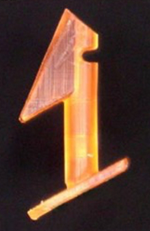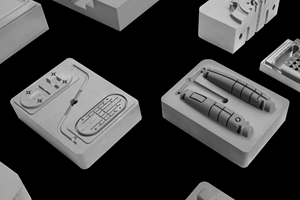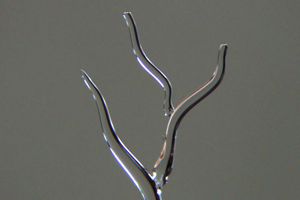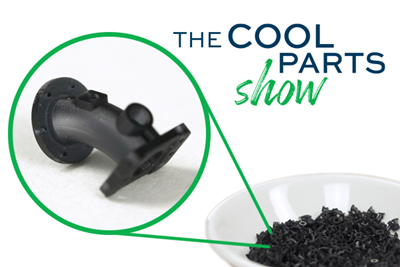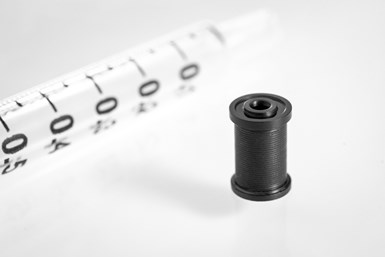
Producing a micro part such as this drug delivery device via traditional machining methods is very challenging. Specialized optical systems, machine components and materials have made 3D printing a viable alternative to micromachining. Photo Credit: Nanofabrica
Micromachining is a very specialized, challenging operation, so it’s natural that companies that require it are looking for an alternative.
Those companies include both makers of tiny parts and the producers of molds with tiny features for tiny parts.
“In micro-parts, sometimes the features and details are nearly impossible, or very difficult, or very expensive to produce,” notes Avi Cohen, executive vice president at Nanofabrica, which produces the Tera 250 micro additive manufacturing system. At first, 3D printing might not seem like an obvious alternative process for producing such tiny parts, given that machining is an operation more associated with precision and fine detail. But according to Cohen, the Tera 250’s optical system, its machine platform and the company’s specialized materials have all been developed to address specific challenges of micro 3D printing.
Optics
Digital light processing (DLP) systems like the Tera 250 rely on an optical system that projects onto a resin vat and cures the part layer by layer. The resolution of this system determines the resolution of the part, and at the small scales of micro 3D printing, this becomes critical. Nanofabrica’s co-founder and CEO, Jon Donner, used his background in optics to develop a smart, adaptive optical system for the Tera 250 that enables the machine to print very small, highly detailed and accurate parts. “Every print, the machine adjusts itself and confirms, so it’s a closed loop,” Cohen says. “We are confirming the focus and then projecting, not just projecting regardless to what happens.” This optical system sharpens detail to a pixel size of 1.9 microns and a layer thickness of 1 micron for accurate, high-resolution micro parts.
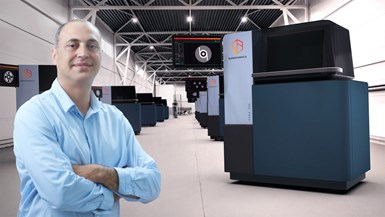
Avi Cohen, executive vice president at Nanofabrica, says that the company’s Tera 250 DLP 3D printing platform has an optical system sharpness that delivers a pixel size of 1.9 microns and a layer thickness of 1 micron. The machine also has a rigid granite table and specialized servo elements and controls that enable precise movements for accurate, high-resolution micro parts. Photo Credit: Nanofabrica
Machine Design
In addition to a specialized optical system, 3D printers that operate on a micro scale also need to be very stable and capable of making fine, accurate movements. To address these challenges, Cohen says the Tera 250’s construction includes a granite table for rigidity and accuracy. The granite itself doesn’t expand and contract like metal, ensuring the machine remains accurate. In addition, the machine itself has specialized servo-elements and controls that enable precise movements. “The maximum error in the movement will not exceed 100 nanometers,” Cohen says.
Materials
Nanofabrica currently produces two materials in house for the system. The company started with an ABS for its popularity, chosen to “attract as many customers as we could,” Cohen explains. The second is a composite material, a polymer reinforced with nanoparticles made of glass, ceramic, zirconia or a mixture of the materials. “Our technology allows us to develop and print different types of composite materials,” Cohen explains. “You can generate new levels of materials and families that didn’t exist before.” This is because DLP doesn’t use a nozzle that could be clogged by the particles.
The nanoparticles are also small enough that they stay dispersed throughout the vat of resin instead of sinking to the bottom. The composite material is stronger and more stable than ABS, and can withstand higher temperatures and wear better as well. The original goal for the development of this material was to produce more durable micro mold inserts that could last for thousands of shots instead of hundreds, although applications extend to production parts as well.
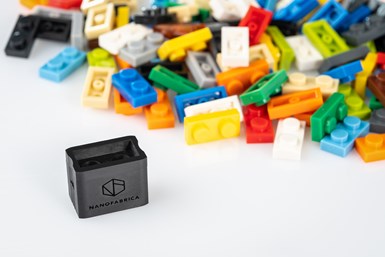
Micro 3D printing can aid users by providing prototyping and short-run production capabilities, while also giving users the ability to 3D print micro molded inserts using a reinforced composite material. Cohen says that while the Tera 250 was initially designed for micro mold production, half of its customers are using the machine for part production. Photo Credit: Nanofabrica
It's a Small World
These three elements have helped 3D printing expand into industries where micro parts are common, such as electronics and medical. Examples Cohen cites include the tooling used in making computer chips, components that need to be made to much the same precision as the chips themselves. He also gives the example of a micro 3D printed drug delivery device — it’s the diameter of a match and has 580 holes that are 50 microns each.
Micro 3D printing is also finding applications at different stages of the part production process, he notes. It allows companies to iterate at the prototyping stage before investing in tooling and processes involving more costly micromachining.
From prototyping, companies can easily make the jump to short-run production. “Since the parts are so small, it doesn’t matter if you place hundreds on one printing job,” Cohen says. “And in terms of cost, each part is maybe one gram, so the material consumption is relatively low.”
Furthermore, these parts generally don’t require much postprocessing — just a rinse in alcohol and removal from the build plate. And any support structures on such small parts are also small and therefore easy to remove either in the alcohol or with air pressure. The result is multiple valid paths to mass production using micro 3D printing.
Directly making a large run of parts this way is a possibility “becoming much more valid,” Cohen says. The other path: Companies can 3D print micro molds. In fact, Nanofabrica initially released the Tera 250 as a platform for printing micro mold inserts. However, Cohen says that currently just half of the company’s customers are using the system to print micro molds, while the other half are using it for part production.
Related Content
The Connector Conundrum: 3D Printed Mold Tooling’s Role in Innovation
ReelView Fishing faced an electronics obstacle in the development of its new technology for underwater video. Additive manufacturing for moldmaking allowed for the speed necessary to iterate to a solution. How inventors and invention will benefit from new ways of obtaining production-ready tooling.
Read MoreComplete Speaker Lineup Announced for the 3D Printing Workshop at NPE2024: The Plastics Show
Presentations will cover 3D printing for mold tooling, material innovation, product development, bridge production and full-scale, high-volume additive manufacturing.
Read MoreCopper, New Metal Printing Processes, Upgrades Based on Software and More from Formnext 2023: AM Radio #46
Formnext 2023 showed that additive manufacturing may be maturing, but it is certainly not stagnant. In this episode, we dive into observations around technology enhancements, new processes and materials, robots, sustainability and more trends from the show.
Read MoreIce 3D Printing of Sacrificial Structures as Small as Blood Vessels
Using water for sacrificial tooling, Carnegie Mellon researchers have created a microscale method for 3D printing intricate structures small enough to create vasculature in artificial tissue. The biomedical research potentially has implications for other microscale and microfluidics applications.
Read MoreRead Next
Micro 3D Printing for Tiny Connectors: The Cool Parts Show #20
Microscale additive manufacturing offers an alternative to micromolding and micromachining. On this episode of The Cool Parts Show, 3D printed electrical connectors are our smallest cool part yet.
Read MoreZooming in on Micro 3D Printing: AM Radio #10A
This week on AM Radio, Peter Zelinski and Julia Hider discuss additive at the extremes, including micro 3D printing. What are the opportunities and challenges of 3D printing on a microscale?
Read MoreCan Microscale 3D Printing Reduce Surgeries for Glaucoma Sufferers?
Boston Micro Fabrication (BMF) is exploring this promise. Eye stents are made of metal today. Fine-detail additive manufacturing can enable polymer instead, improving patient experience.
Read More




